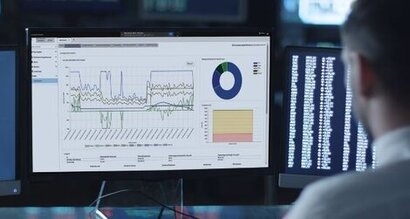
The portfolio tightly integrates advanced analytics with both software and hardware systems to maximise system performance and value, while reducing the overall carbon footprint.
New updates include:
Vehicle to grid (V2G) readiness for electric vehicle fleets
Options for advanced cloud-based performance and monitoring applications
Flexible design improvements to the PowerStoreTM battery energy storage system
Expanded controls and automation
e-mesh is part of the Hitachi Energy services network of collaborative operations centres. That network provides customers with global 24/7 support and ready access to unmatched technical and domain expertise. Hitachi Energy’s combined digital and service offerings accelerate customer outcomes and reduce CapEx with performance and availability guarantees, extended warranties, and other offerings across the product lifecycle.
With this release, e-mesh is also now well-suited for the fleet EV charging market. This infrastructure requires advanced technologies to control, optimise and coordinate the vehicle charging process, better integrating it with battery energy storage systems and local Distributed Energy Resources (DERs), with many of the same requirements as a complex microgrid. As use cases evolve, e-mesh provides a platform to address a range of needs, including managing large EV fleet depots, coordinating fast-charging stations, and optimising EV recharging.
“The entire energy market is transforming, and the challenges are expanding in scope and urgency” said Maxine Ghavi, head of Grid Edge Solutions for Hitachi Energy. “It is no longer about one transformation. It is about many changes happening at once, and is always built on more electrification. We have heard from customers around the globe that they don’t just want a single product for a microgrid, energy storage, or a control system. They want a flexible and optimised solution for reducing complexity, providing the highest penetration of renewables, while increasing overall stability and reliability. This also means they will ultimately need more digital services for their own management, productivity, and growth.”
Scott Gibson, principal engineer with Snohomish County Public Utility District (SnoPUD), added that as demand increases for more renewable energy and V2G readiness, battery energy storage, with exceptional reliability, becomes the linchpin for future infrastructure and that the right control and automation technologies are also needed to synchronise assets in order to maximise and optimise microgrid system performance.
“By working with Hitachi Energy, we are looking ahead to a future where we can pave a sustainable path, maximise renewable integration and address future energy needs” Mr Gibson said.
New features in e-mesh include:
PowerStore, a grid-forming battery energy storage systems (BESS) for both grid-connected and off-grid applications, which is now available in integrated or modular versions, covering an increasingly larger range of power ratings in line with bigger customer projects. This also includes global UL/EU/AU-grid code converter certifications for safety and reliability, designed to be more interoperable and flexible. PowerStore provides grid stabilisation with added energy storage and cyber security enhancements for large-scale projects.
e-mesh EMS improves energy management, reducing electric utility bills through strategic operation of BESS and other distributed energy resources, including support for load management and electric vehicles. EMS maximises the value of renewable generation.
e-mesh Monitor further extends asset and operational performance to a cloud-based platform, aggregating data from distributed energy resources (DERs) and turning that into actionable business insights. The solution includes cyber-security and remote updates and troubleshooting.
Options for both advanced MicroSCADA automation and RTU-based control combine traditional and renewable generating assets into a single view for simplified operations.
For additional information:

